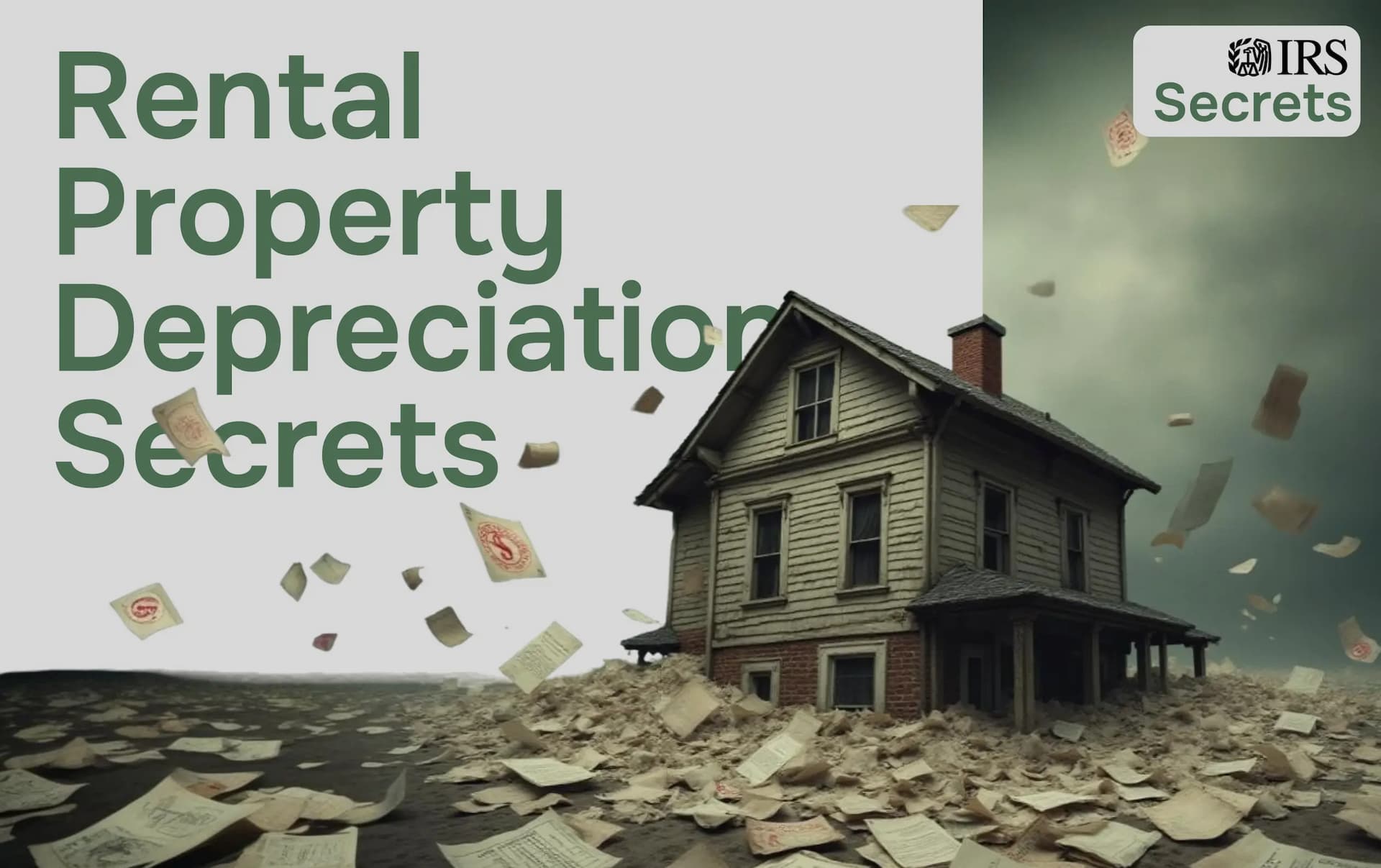
Ever wondered how real estate investors seem to win at tax season? One word: depreciation.
If you own a rental property or are thinking about diving into the real estate game this blog is for you. We’re going to break down what rental property depreciation is, how to calculate it, why it’s awesome for your wallet, and how to avoid giving too much of it back to Uncle Sam when you sell.
And if you're tired of navigating this alone? Don’t worry, we’ve got a secret weapon for you at the end.
What is Rental Property Depreciation?
Rental property depreciation is a tax deduction that lets you recover the cost of the building (not the land) over time due to wear and tear, aging, or obsolescence.
Imagine your rental property is like a car. Over time, even though it might still run well, it naturally wears down and loses value due to weather, aging, and general wear and tear.
Now here’s the cool part: the IRS knows this happens, and they let you write off part of that lost value every year as a tax deduction. That’s depreciation.
In plain terms:
Depreciation = a yearly tax break because your building is getting older.
But remember: You can only depreciate the value of the building, not the land it sits on because land doesn’t wear out.
You can start claiming depreciation as soon as the property is "in service" (i.e., ready and available to rent). You keep claiming it until you’ve fully recovered the cost of the building or you sell the property whichever comes first.
How to Calculate Depreciation on Rental Property
Calculating depreciation might sound intimidating at first, but it’s actually a pretty straightforward process once you understand the key steps. Let’s walk through what you need to know.
Step 1: Determine Your Property’s Basis
Your “basis” is the starting point for calculating how much depreciation you can claim. Many people think it’s just the purchase price of the property but it’s more than that.
Your basis includes:
• The price you paid for the property
• Legal fees related to the purchase (such as attorney fees, title fees, or abstract fees)
• Recording and transfer fees
• Any seller debts you agreed to pay (like unpaid property taxes)
• And this is important, capital improvements, like a new roof, Heating, Ventilation, and Air Conditioning system (HVAC), kitchen remodel, or any upgrade that adds value or extends the life of the property.
Repairs and maintenance do not count toward the basis; only improvements do.
Step 2: Use the IRS-Defined Recovery Period
Now that you have your depreciable basis (i.e., the value of just the building plus improvements), it’s time to figure out how long you’ll be depreciating it.
According to the IRS:
• Residential rental properties are depreciated over 27.5 years
• Commercial rental properties are depreciated over 39 years
This system is known as the Modified Accelerated Cost Recovery System (MACRS), which is required for properties placed into service after 1986. In most cases, you’ll be using the General Depreciation System (GDS) under MACRS, which applies straight-line depreciation meaning you deduct the same amount every year.
If you’re using the property in a unique way say, for agriculture or for a nonprofit or using it less than 50% for qualified business purposes, you may have to use the Alternative Depreciation System (ADS) instead, which has different rules and longer recovery periods. But for most rental property owners, GDS is the go-to method.
Step 3: Calculate Your Annual Depreciation
Here’s where it all comes together.
Once you’ve determined your depreciable basis and confirmed the recovery period (27.5 years for residential), you simply:
Divide the depreciable amount by the number of years
This gives you your annual depreciation deduction, the amount you can subtract from your rental income each year on your taxes.
So, if your building’s basis is $275,000:
$275,000 ÷ 27.5 = $10,000 per year
That’s $10,000 of income you won’t be taxed each year, just because the IRS assumes the building is aging.
Benefits of Claiming Depreciation
• Lower your taxes: Less taxable income = lower tax bill.
• Boost your profits: You keep more of the rent you earn.
• Increase ROI: Less money to the IRS = more money to reinvest.
• Stay in a lower tax bracket: Especially helpful if you’re close to a cutoff.
What is Depreciation Recapture?
Alright, so you’ve been smart.
You bought a rental property. You’ve been claiming depreciation every year, reducing your taxable rental income. Life’s good.
But now you’re thinking about selling that property.
Here’s where the IRS steps in and says:
“Hey, we gave you tax breaks for the property losing value over time. Now that you’re selling it, we want to recapture those deductions and tax you on them.”
That’s what depreciation recapture means.
Depreciation recapture is a special tax that applies when you sell a rental property and you've claimed depreciation deductions during the time you owned it.
When you sell, the IRS treats all that depreciation you wrote off as taxable income even though you never actually "earned" it.
And they want a cut.
You pay up to 25% tax on the total depreciation you've claimed.
This is separate from capital gains tax. So, when you sell a rental property:
• One portion of your gain is taxed as capital gains (at 15–20% depending on your income)
• The portion equal to the depreciation you claimed is taxed as depreciation recapture (capped at 25%)
Even if your property didn't appreciate much or if you sold it at a loss, you still owe depreciation recapture tax.
How to AVOID Depreciation Recapture: The Power of the 1031 Exchange
If you're planning to sell a rental property and want to keep growing your real estate portfolio without getting hit with a big tax bill, here's the golden strategy: the Section 1031 Exchange.
Also called a like-kind exchange, this method lets real estate investors defer taxes that would normally be due when they sell a rental property including depreciation recapture, capital gains tax, state taxes, and even Net Investment Income Tax (NIIT), if it applies.
What is a 1031 Exchange?
A 1031 Exchange is basically a swap of one investment property for another. Instead of cashing out when you sell, you reinvest all your profits into a new property, and the IRS says, "Cool, you're still investing we won't tax you yet."
Basic 1031 Exchange Requirements (You must follow these rules carefully)
• Must Use a Qualified Intermediary (QI): You can’t touch the sale money; it must go through a QI who handles the 1031 process.
• Identify New Property Within 45 Days: You have 45 days from the sale to formally identify the property you plan to buy.
• Close Within 180 Days: You must complete the purchase of the new property within 180 days of the sale.
• Must Be Equal or Greater Value: To avoid taxes, the new property must be of equal or higher value than the one you sold.
Need Help Navigating This?
Depreciation, recapture, and 1031 exchange can get tricky. One wrong move and you might lose thousands in missed deductions or surprise tax bills.
That’s where ProcStat steps in. We specialize in property management and rental property accounting. Whether you’re a first-time investor or scaling your real estate portfolio, we help:
• Calculate your depreciation accurately
• Track improvements and adjustments
• Guide you through depreciation recapture and 1031 exchanges
• Keep your property records audit-ready and IRS-proof
Let your numbers work smarter, not harder. ProcStat’s got your back.

Shekhar Mehrotra
Founder and Chief Executive Officer
Shekhar Mehrotra, a Chartered Accountant with over 12 years of experience, has been a leader in finance, tax, and accounting. He has advised clients across sectors like infrastructure, IT, and pharmaceuticals, providing expertise in management, direct and indirect taxes, audits, and compliance. As a 360-degree virtual CFO, Shekhar has streamlined accounting processes and managed cash flow to ensure businesses remain tax and regulatory compliant.
You might also like:
- 9 Practical Strategies to Improve Cash Flow for Small Businesses
- Qualified Improvement Property (QIP): The Smart Way to Accelerate Depreciation on Commercial Renovations
- Why Smart E-Commerce Owners in the U.S. Are Outsourcing Their Accounting
- The Ultimate Guide to SaaS Accounting: Metrics, Revenue, and Growth Hacks
Listen Exclusive Podcast On

